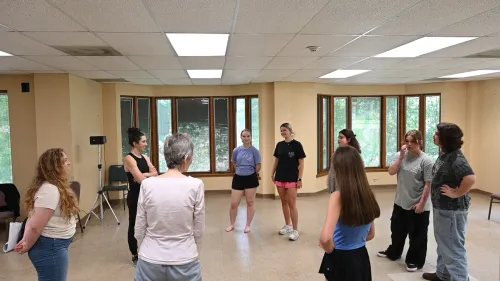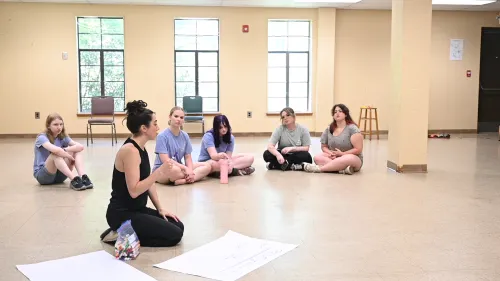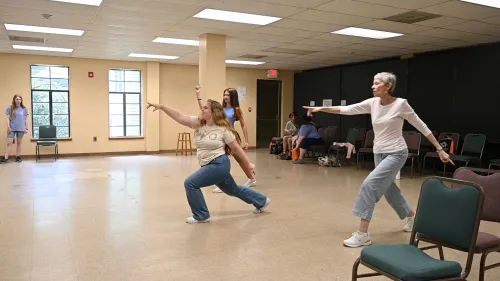Dance as spiritual practice
Lindsey Hanson, a professional dancer who now teaches dance at Hope College, helps students develop both confidence and choreography

MONTREAT, North Carolina — Lindsey Hanson, an assistant professor of dance at Hope College in Holland, Michigan who previously had an extensive career as a dancer and actress in New York, spent the week at the Worship & Music Conference teaching students how dance can be a spiritual practice.

“What you do in your daily life is a small pocket of what your body can do,” she told Presbyterian News Service during a break in one of the classes she offered this week. “We are uncomfortable in our body, but God created your body beautiful and loves every part of it and delights in it. It’s a wonderful creation, and the more I learn about anatomy, the more mind-blowing it is.”
Hanson said that when she’s dancing her hardest, “it’s an act of worship.” Her goal at the conference, put on each year by the Presbyterian Association of Musicians, is “to give everyone the opportunity to move in a way they didn’t think was possible.”
Her students were taking 10 minutes to choreograph a brief dance they could teach to a partner. “They’re off their phones being creative and problem-solving, and I think that’s a beautiful thing,” Hanson said. Even her fellow professional dancers will sometimes say, “I can’t believe we created that.”
“God made us dancing bodies,” Hanson reasoned. “Why not provide them the opportunity to experience that?”

Hanson opened class sessions with a fun warmup, spending time in each of four Laban categories: weight, space, speed and flow. As they changed positions, Hanson offered up encouragement. “Think of all three planes” through which the body moves, she said. “If you incorporate all three, you get a nice 3-D shape that feels good on your spine.”
With direct space, “go to one part of the room, then another.” With indirect space, “every part of the room is interesting at the same time.”
Under bound flow, “make a decision. Free flow is spontaneous,” she said. “Surprise yourself.”

After a break, students brainstormed what pride might look like in a dance. It was an interesting choice, because the theme for the day at the conference was humility.
Students offered up qualities including exhibiting an elevated posture, taking up a lot of space, being spatially disrespectful and taking what one wants.
Hanson gave students some guidance for their brief choreography: The first movement was a turning action infused with pride. “It doesn’t have to be a triple pirouette,” she said. “Make sure it’s clear and you can repeat it. Do it a few times and get it in your body.”
The second was a change of focus. “Incorporate your body, first here, then here,” Hanson said, demonstrating what could be done.
The third movement is a level change — low to high, high to low, jump or lie down. It could be anything, Hanson said.
The fourth was to develop an arm movement, and Hanson demonstrated several options to give students ideas.
“This is the fastest you will ever choreograph anything,” she told students. “Find someone you don’t know and teach them your phrase. Go!”

Once they’d taught one another in groups of two or three, students demonstrated what they’d come up with. The groups did well and rewarded one another with applause.
Then Hanson asked: What was it like to take four innocent movements and make it into a dance?
“I liked the mashups of different dances,” said one.
“I liked seeing how people’s brains work,” said another.
“I like presenting and showing,” said a third.
“I think if I’d told you you’d be presenting at the start of the class, you might have hesitated,” Hanson said. “It was your own journey. Pat yourself on the back. That took a lot of courage.”
Later, she said if she’d been the one to teach students their moves, “they would have had a harder time. When you strive together with other people, you build a better memory response.”
You may freely reuse and distribute this article in its entirety for non-commercial purposes in any medium. Please include author attribution, photography credits, and a link to the original article. This work is licensed under a Creative Commons Attribution-NonCommercial-NoDeratives 4.0 International License.




